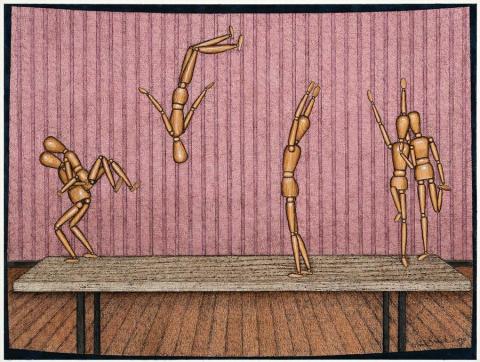THE TUMBLERS, 1990
John Brack
watercolour, pen and ink on paper
68.5 x 91.5 cm
signed and dated lower right: John Brack 90
Rex Irwin Art Dealer, Sydney (label attached verso)
Private collection, Sydney (acquired from the above 1998)
Grishin, S., The Art of John Brack: Catalogue raissoné, Oxford University Press, Melbourne, 1990, volume II, cat. p312, p. 74
'...John was getting older, and so he was starting to think of the future - not his future but the future. And when the 1980s came (and it did synchronize with grandchildren coming) there was a realising that it was the same again - we'd very much seen this, been there. That was the beginning of his making of an image for perpetuation...'1
Acutely aware of his own frailty and the inevitability of death, during the early 1990s Brack sought an image to describe this chapter of human experience - one that would encapsulate the continuation of life, the perpetual cycle of renewal as one generation succeeded the next. Accordingly, where the rough and tumble of schoolyards, the antics of jockeys and horse racing, the mundane icons of urban reality and the rigours of ballroom dancing - to name but a few - had previously afforded a platform for investigating the human condition, now in his final meditations exemplified by The Tumblers, 1990, it is the stylised, flesh-coloured manikins which serve as a visual metaphor for people.
More specifically, the motif may be perceived as referencing the next generation - the dancing and tumbling dolls emblematic of children learning to interrelate. As Christopher Heathcote intuitively argued at the time of the series' inaugural exhibition, 'The cipherlike unpainted dolls appear to denote psychologically unformed children. As for what they are doing, the gymnastics and ballroom dancing is an allegory for children learning social rituals, with each doll practicing [sic.] how to behave and interact with others.'2 Thus, although tinged with the artist's personal darkness, such manikin paintings are noticeably bereft of his past pessimism for the ills of the world - embodying rather hope and acceptance of the greater replenishing cycles of life.
Poignantly perhaps, Brack's coda to his artistic career also represented a tender, parting homage to his own immediate family; as his wife Helen Maudsley elucidated in her eulogy, 'For me, personally, the nicest thing John could have done, the nicest acknowledgement to us all, all 5 of us, was that final summing up series of his life's work, the manikin paintings that related to us as a family.'3 Culminating in On Stage 1993 which features five manikins (one large denoting his wife and four smaller, his children) juxtaposed alongside the male Hands of Authority (the artist) on a round marble table (the circle of life), indeed the series is eloquent testimony to the artist's ultimate faith that life would continue as it always had, whether he was here or not: 'when John looked at our daughters, as mothers, he didn't see them, he saw me, and their children " his grandchildren " he saw our children. There was an interchange of generation, of continuation, the Patterns of Perpetuation, that life goes on and repeats itself, even as the blinds come down.'4
1. Helen Maudsley cited in Gott, T., A Question of Balance: John Brack 1974 - 1994, Heide Museum of Modern Art, Melbourne, 2000, p. 34
2. Heathcote, C., 'Still demanding and illusory', The Age, Wednesday 1 June 1994
3. Helen Maudsley, 'A Tribute to John', speech delivered at John Brack's funeral service, St Mark's Anglican Church, Camberwell, 16 February 1999
4. Helen Maudsley cited in Gott, ibid., p. 41
VERONICA ANGELATOS
